Preliminary report released 22 December 2023
This preliminary report details factual information established in the investigation’s early evidence collection phase, and has been prepared to provide timely information to the industry and public. Preliminary reports contain no analysis or findings, which will be detailed in the investigation’s final report. The information contained in this preliminary report is released in accordance with section 25 of the Transport Safety Investigation Act 2003.
The occurrence
On 20 September 2023, trams 6058 and 6062 were operating on route 96 between Brunswick East and St Kilda Beach in Melbourne. Tram 6058 departed St Kilda Beach at about 0912 travelling towards Brunswick East, and tram 6062 departed Brunswick East at about 0936 travelling towards St Kilda Beach. At about 0951, both trams on parallel tracks approached the Nicholson Street intersection with Victoria Parade (Figure 1).
Figure 1: Intersection of Nicholson Street and Victoria Parade
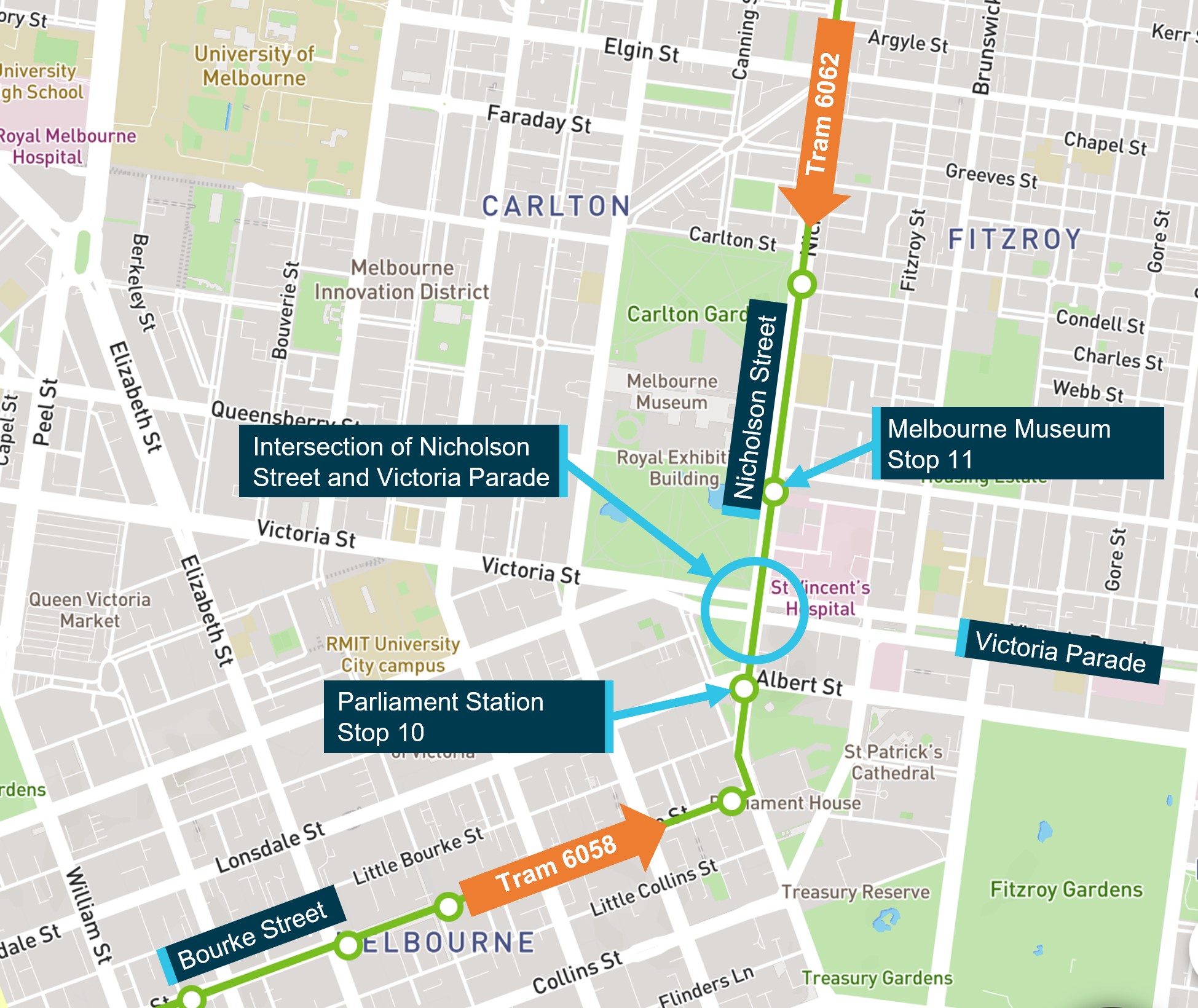
Source: Public Transport Victoria annotated by the Office of the Chief Investigator Transport Safety
Preceding tram 6058 to the intersection was tram 6011. Tram 6011 arrived at the intersection at about 0950 and the points were switched for the tram to turn right and proceed along Victoria Parade.
The collision
After stop 11, tram 6062 proceeded south along Nicholson Street to the intersection with Victoria Parade. Traffic signals indicated that trams and road vehicles travelling south on Nicholson Street could proceed and tram 6062 commenced entering the intersection.
Tram 6058 was travelling north on Nicholson Street and in the opposite direction to tram 6062. After stopping at the Parliament Station stop (stop 10), tram 6058 proceeded up Nicholson Street towards the intersection with Victoria Parade. Traffic signals indicated that trams and road vehicles travelling north on Nicholson Street could proceed and tram 6058 commenced entering the intersection.
As the two trams on parallel tracks converged, tram 6058 turned to the right and into the path of tram 6062, colliding with tram 6062 at about 0952 (Figure 2). The driver of tram 6058 had expected to travel straight across the intersection.
Figure 2: Images of trams superimposed on a view of the intersection of Nicholson Street and Victoria Parade to show the paths of trams 6058 and 6062 leading to collision
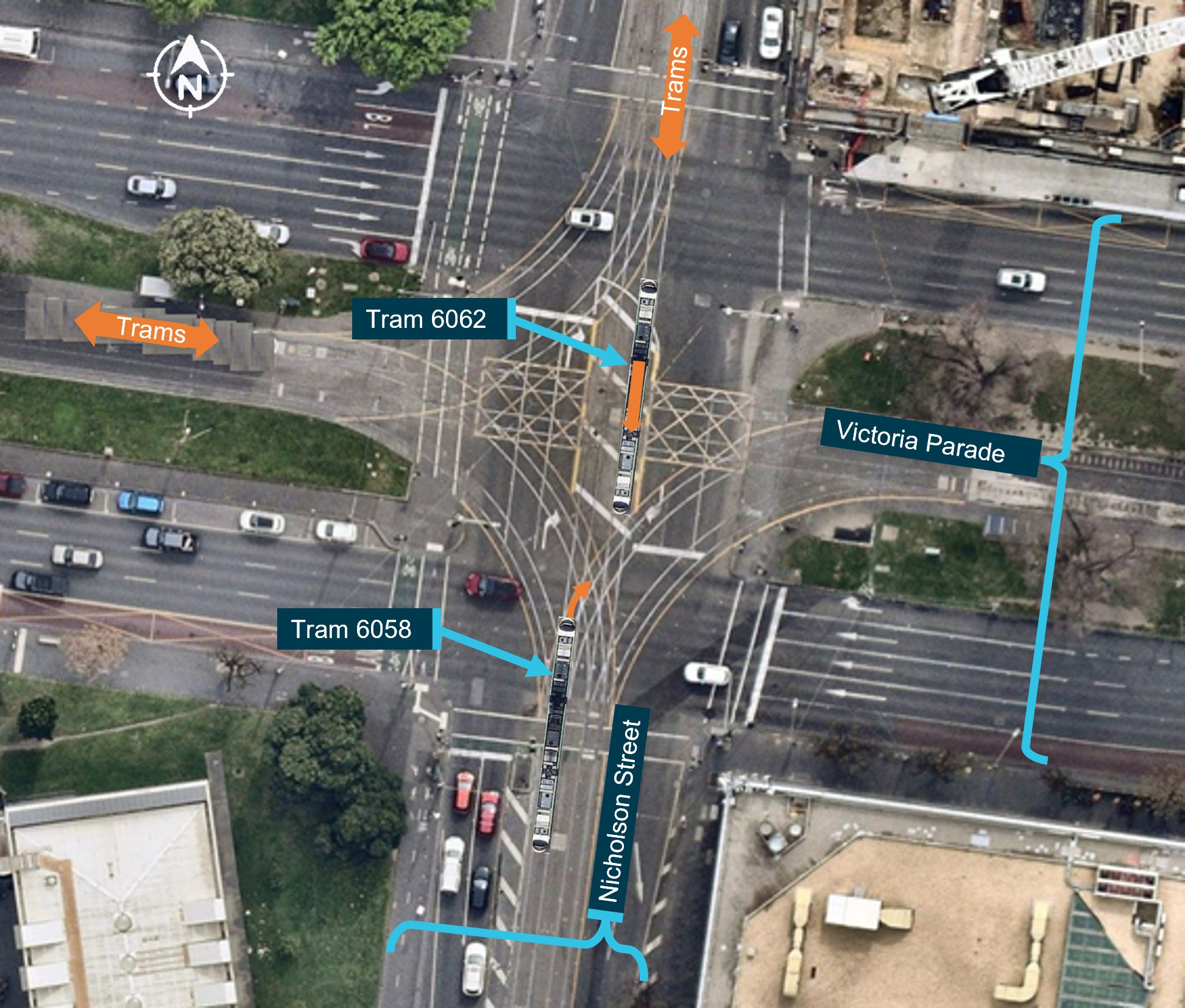
The tram images superimposed on the aerial view of the intersection are not the actual trams, nor their precise locations prior to collision.
Source: Nearmap, annotated by the Office of the Chief Investigator Transport Safety
Tram 6058 had travelled through 2 sets of points. The first set of points were set for the straight, and the second set of points were set for the right turn (Figure 3).
Figure 3: Image from CCTV footage showing the settings of the 2 sets of points
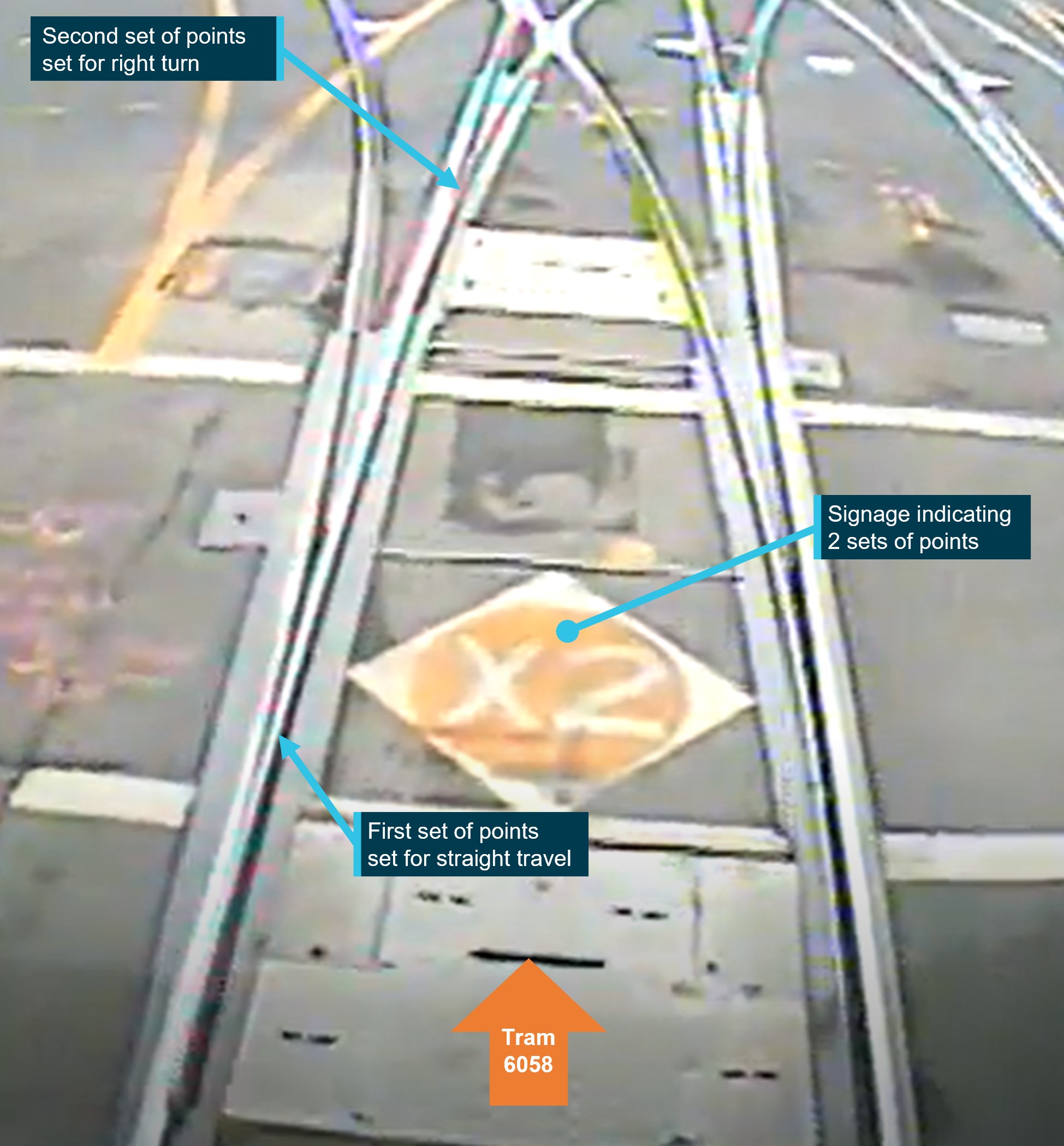
Source: Yarra Trams (tram 6058 CCTV) annotated by the Office of the Chief Investigator Transport Safety.
Each tram was travelling at about 20 km/h at the time of the collision. The driver of tram 6062 and 5 passengers sustained minor injuries. Both trams derailed and sustained considerable damage to their front and right-hand panels (Figure 4).
Figure 4: Damage to tram 6058 and tram 6062
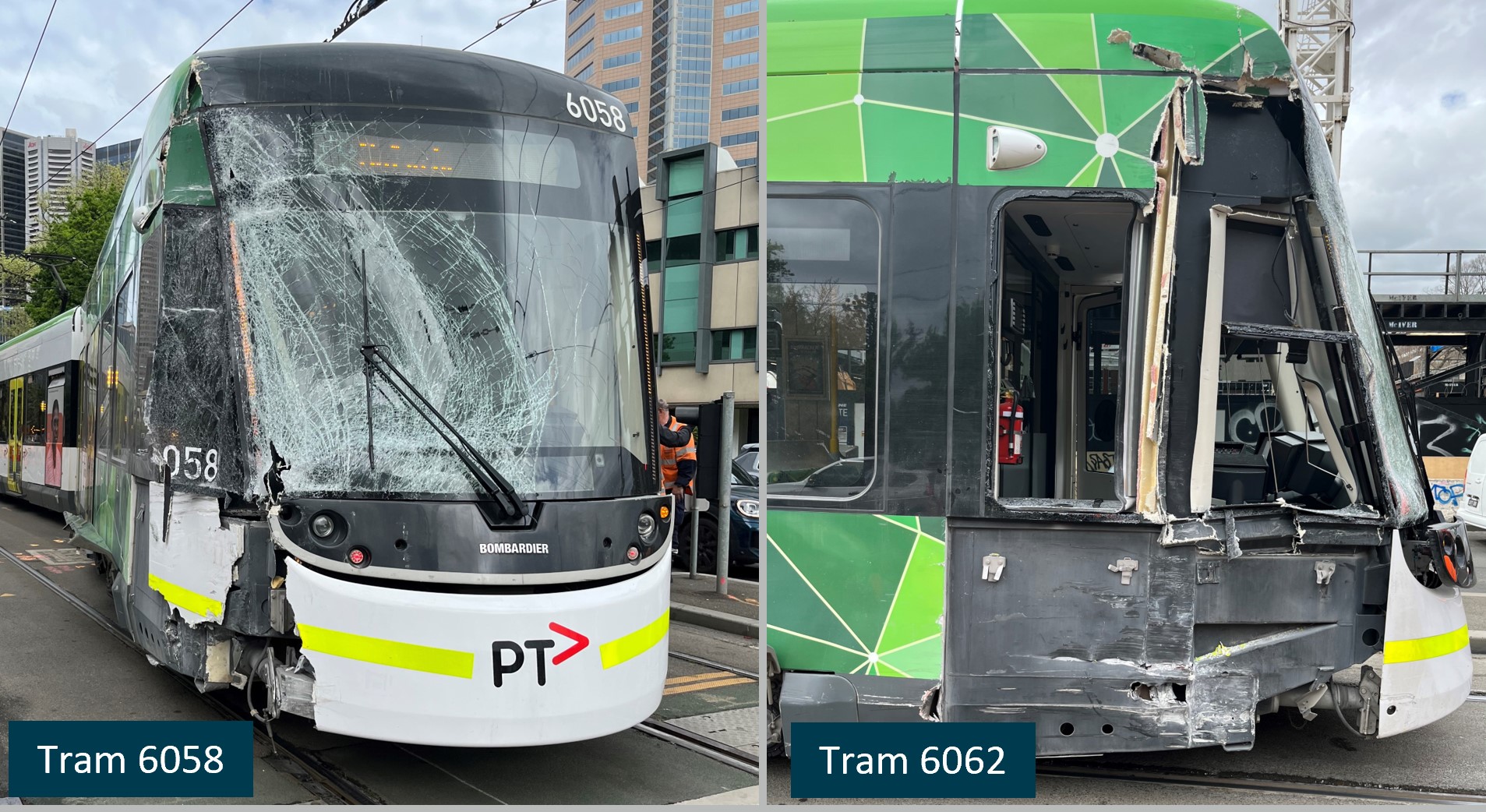
Source: Office of the Chief Investigator Transport Safety.
Context
Management of the tram network
Yarra Trams was the accredited operator of the Melbourne tram network and was responsible for the operation and maintenance of rolling stock and network infrastructure. Network infrastructure was leased to Yarra Trams by the Department of Transport and Planning on behalf of the Victoria State Government.
Trams
Trams 6058 and 6062 were both E2 class trams manufactured by Bombardier Transportation Australia. Each tram was comprised of 3 connected passenger units, giving a total length of about 33 m and a capacity of 64 seated and 146 standing passengers (Figure 5).
Figure 5: The articulated E2 Class tram

Source: Yarra Trams, annotated by the Office of the Chief Investigator, Transport Safety.
The intersection
Victoria Parade was a dual carriageway with a tram-only thoroughfare between carriageways. Nicholson Street was a two-way single carriageway south of Victoria Parade, and a dual carriageway with a tram-only thoroughfare north of the intersection.
Except for the city-circle service, normal service routes on Nicholson Street and Victoria Parade passed straight through this intersection. Trams on routes 86 and 96 travelled north and south along Nicholson Street, while trams on route 30 travelled east and west along Victoria Parade. City circle trams travelling north on Nicholson Street would turn left into Victoria Parade.
There was no scheduled service that required north-travelling trams on Nicholson Street to turn right into Victoria Parade. Trams would only turn right into Victoria Parade if travelling on an amended route or being directed to another location.
Signals
Northbound trams travelling along Nicholson Street were presented with traffic signals and primary and secondary points lanterns (Figure 6). When permitted to proceed straight, northbound trams were presented with a white arrow at 4 locations within the intersection.
Figure 6: Traffic signals at intersection when travelling north on Nicholson Street
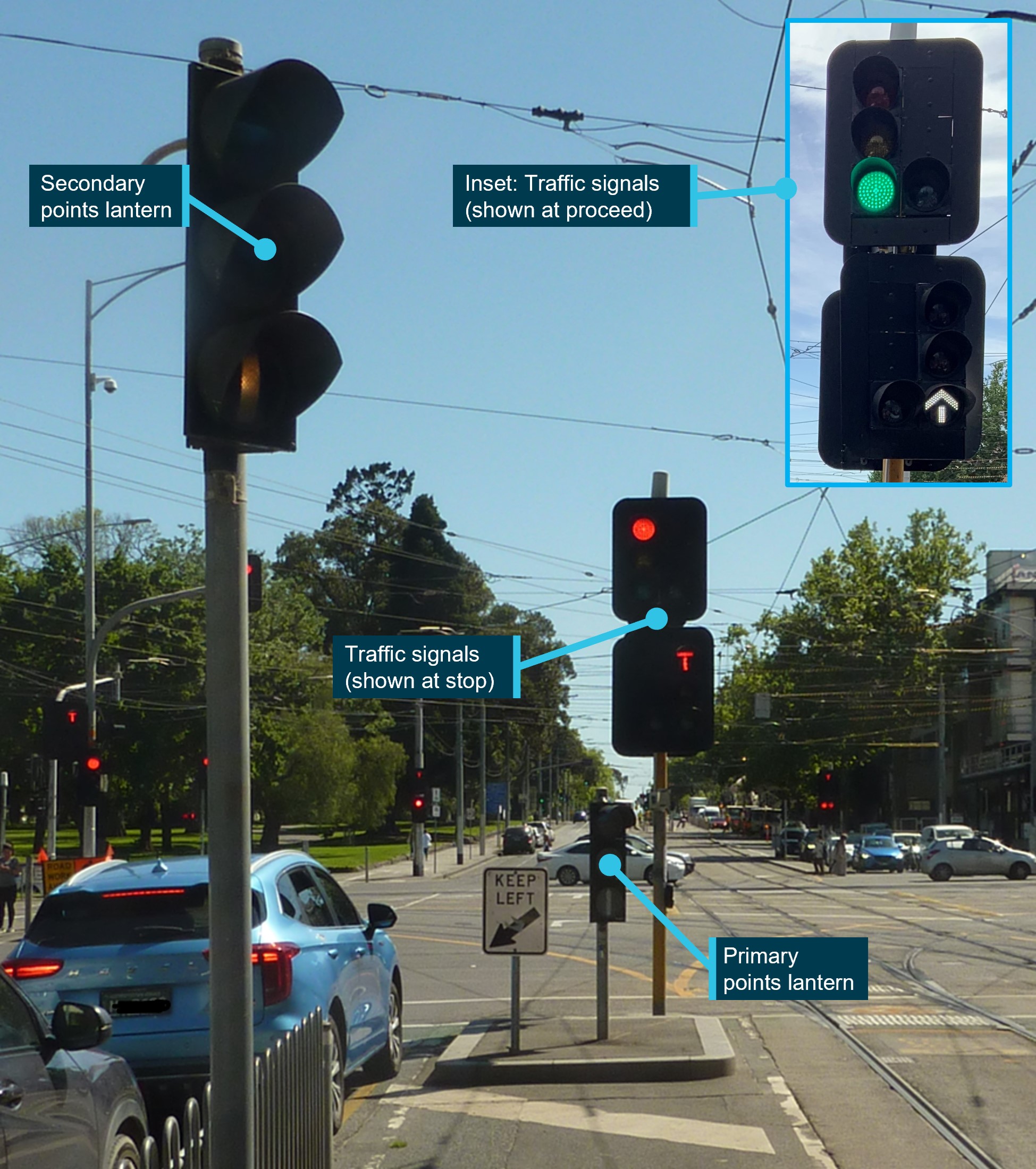
This figure does not represent the condition of the points lanterns at various times during the sequence of events for this incident.
Source: Office of the Chief Investigator Transport Safety.
The primary points lantern had 3 lenses with each lens designed to have an unlit (nil) or lit aspect (Figure 7). The central lens had 2 possible lit aspects and could indicate that the points were set to the left or to the right. The secondary points lantern was of the same configuration, however, on the day of the incident its central lens was non-operational.
Figure 7: The primary points lantern and the possible lit aspects of each lens
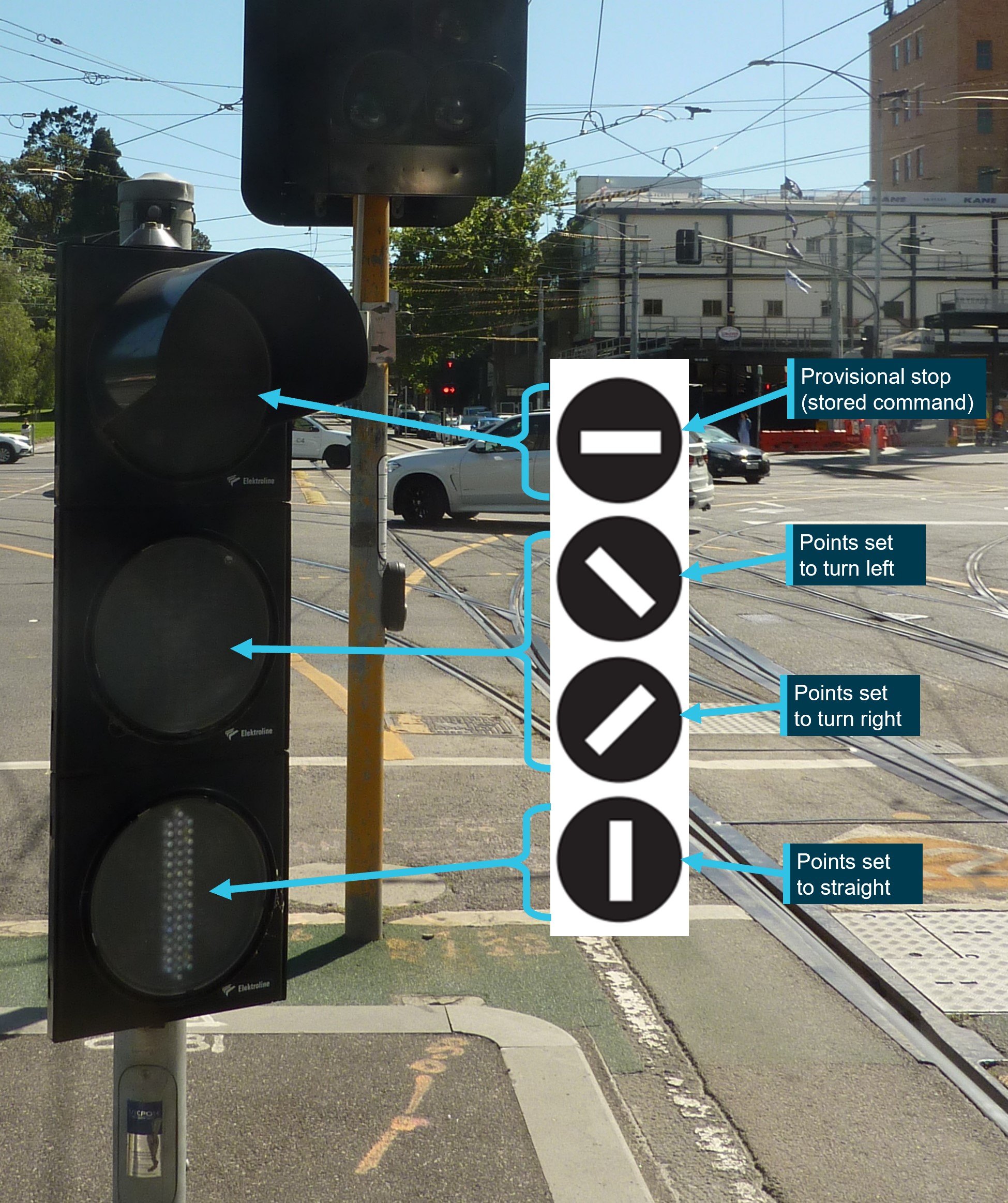
This figure does not represent the condition of the primary points lantern at various times during the sequence of events for this incident.
Source: Office of the Chief Investigator Transport Safety and Yarra Trams (signal aspects)
In-track equipment and surface markings
The intersection of Nicholson Street with Victoria Parade was fitted with automatic points. Travelling north on Nicholson Street and approaching the intersection, in-track equipment interfaced with trams to provide input to the operation of points, and on-ground markers provided visual cues to drivers (Figure 8).
Figure 8: Track equipment and markings on Nicholson Street travelling north
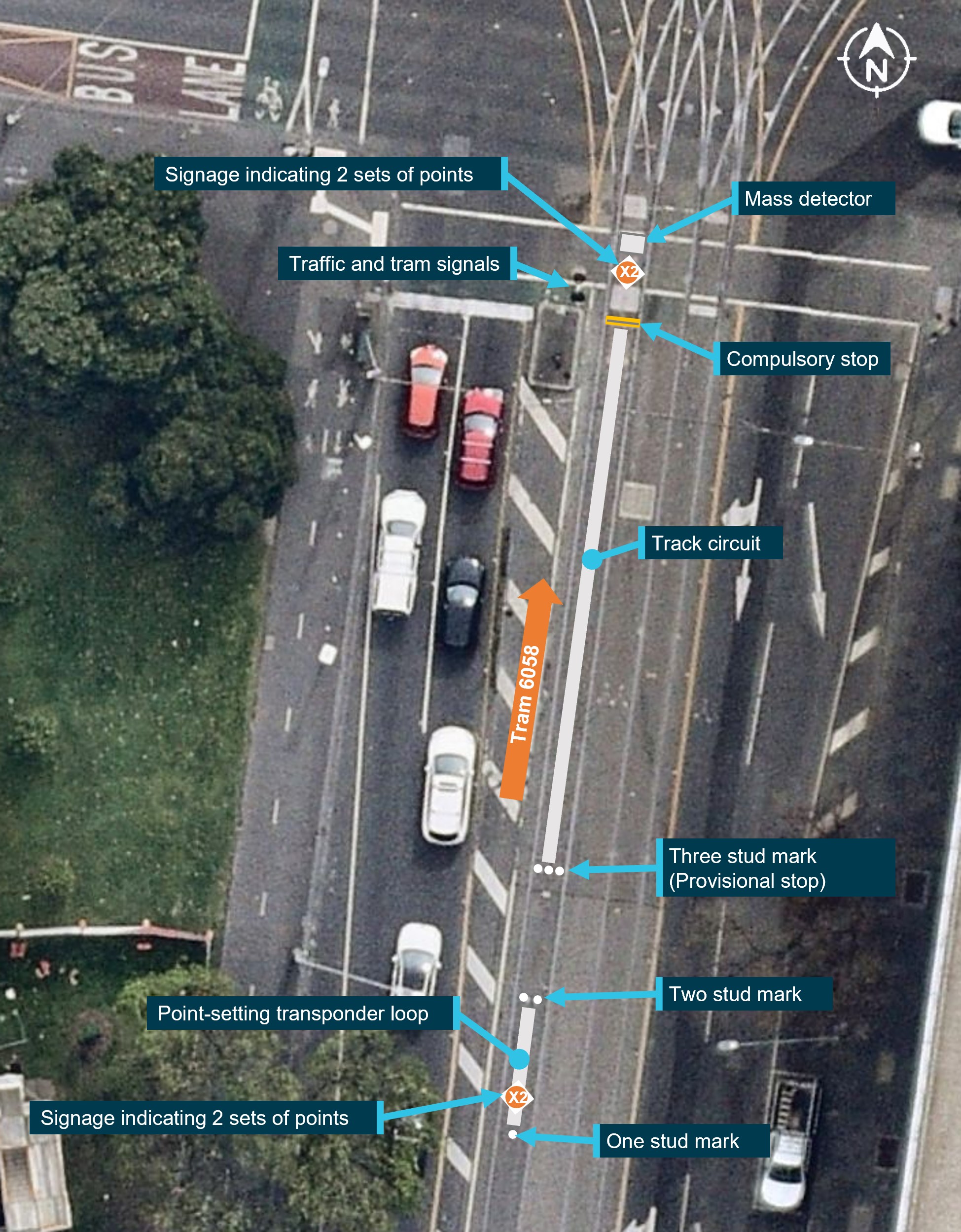
Source: Nearmap, annotated by the Office of the Chief Investigator Transport Safety
In-track equipment included (Figure 8):
- a points-setting transponder loop located between the 1 and 2-stud marks that was designed to receive a (driver initiated) points-selection transmission from the tram
- a track circuit located between the 3-stud mark (provisional stop) and compulsory stop that was designed to detect the presence of the tram and lock the selected points setting in position to protect against a following tram changing the position of the points
- a mass detector located past the compulsory stop that was also designed to protect against a change to the points position prior to the tram clearing the points.
Similar occurrence
On 19 November 2023 at about 1711, tram 6030 on route 86 was travelling north on Nicholson Street and approached the Victoria Parade intersection. It followed a tram that had earlier turned right into Victoria Parade. The driver brought the tram to a stop at the intersection and awaited traffic signals to proceed straight, and across, Victoria Parade. However, on the tram proceeding, it followed the points that had been set to the right turn for the previous tram. Realising the tram was off route, the driver immediately brought the tram to a stop without conflict to other trams or road traffic.
Further investigation
To date, investigators from the Office of the Chief Investigator Transport Safety have inspected the investigation site, conducted interviews and continue to collect evidence.
The investigation is continuing and will include the review and examination of:
- operation of both trams
- the function and operation of tram equipment
- the operation of track infrastructure, signalling and traffic management systems
- the design and arrangement of infrastructure at the intersection
- the management of safety risk associated with trams deviating from their designated route
Should a critical safety issue be identified during the course of the investigation, the ATSB will immediately notify relevant parties so appropriate and timely safety action can be taken.
A final report will be released at the conclusion of the investigation.
About the ATSB
The ATSB is an independent Commonwealth Government statutory agency. It is governed by a Commission and is entirely separate from transport regulators, policy makers and service providers.
The ATSB’s purpose is to improve the safety of, and public confidence in, aviation, rail and marine transport through:
- independent investigation of transport accidents and other safety occurrences
- safety data recording, analysis and research
- fostering safety awareness, knowledge and action.
The ATSB is responsible for investigating accidents and other transport safety matters involving civil aviation, marine and rail operations in Australia, as well as participating in overseas investigations involving Australian-registered aircraft and ships. It prioritises investigations that have the potential to deliver the greatest public benefit through improvements to transport safety.
The ATSB performs its functions in accordance with the provisions of the Transport Safety Investigation Act 2003 and Regulations and, where applicable, international agreements.
Rail safety investigations in Victoria
Most transport safety investigations into rail accidents and incidents in Victoria and New South Wales (NSW) are conducted in accordance with the Collaboration Agreement for Rail Safety Investigations and Other Matters between the Commonwealth Government of Australia, the State Government of Victoria, and the State Government of New South Wales. Under the Collaboration Agreement, rail safety investigations are conducted and resourced in Victoria by the Chief Investigator, Transport Safety (CITS) and in New South Wales by the Office of Transport Safety Investigations (OTSI), on behalf of the ATSB, under the provisions of the Transport Safety Investigation Act 2003.
The Chief Investigator, Transport Safety (CITS) is a statutory position established in 2006 to conduct independent, no-blame investigation of transport safety matters in Victoria. CITS has a broad safety remit that includes the investigation of rail (including tram), marine and bus incidents.
Purpose of safety investigations
The objective of a safety investigation is to enhance transport safety. This is done through:
- identifying safety issues and facilitating safety action to address those issues
- providing information about occurrences and their associated safety factors to facilitate learning within the transport industry.
It is not a function of the ATSB to apportion blame or provide a means for determining liability. At the same time, an investigation report must include factual material of sufficient weight to support the analysis and findings. At all times the ATSB endeavours to balance the use of material that could imply adverse comment with the need to properly explain what happened, and why, in a fair and unbiased manner. The ATSB does not investigate for the purpose of taking administrative, regulatory or criminal action.
Terminology
An explanation of terminology used in ATSB investigation reports is available on the ATSB website. This includes terms such as occurrence, contributing factor, other factor that increased risk, and safety issue.
|
Yarra Trams was the trading name of the franchisee, Keolis Downer, for the operation of trams in Melbourne.
Infrastructure was owned by the Victorian Rail Track Corporation (VicTrack), a State Government owned enterprise which owns railway and tram infrastructure in Victoria.
The 3-unit E2 class tram was bi-directional and fitted with a driving cabin at each end.
The service between Docklands to St Vincents Plaza.
The aspects of the points lantern are described in the General Rules and Driving Rules, Keolis Downer, February 2017










